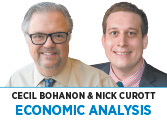Subscriber Benefit
As a subscriber you can listen to articles at work, in the car, or while you work out. Subscribe Now Is the United States headed toward stagflation? Stagflation refers to a time of both weak economic growth and high inflation. Stagflation creates a conundrum because macroeconomic policies aiming to reduce inflation raise unemployment, and policies designed to reduce unemployment raise inflation.
Is the United States headed toward stagflation? Stagflation refers to a time of both weak economic growth and high inflation. Stagflation creates a conundrum because macroeconomic policies aiming to reduce inflation raise unemployment, and policies designed to reduce unemployment raise inflation.
The last time the U.S. economy suffered stagflation was in the 1970s. In 1973, the OPEC cartel restricted oil production, causing the price of oil to quadruple. This negative supply shock raised the cost of production for many U.S. companies, causing them to lay off workers and raise prices. The Federal Reserve was befuddled, first raising interest rates to fight inflation, then cutting them to fight the recession. Ultimately, the Fed unintentionally landed on an easy monetary policy, pouring fuel on the Great Inflation of the 1970s.
Conditions today are ripe for another stagflation episode. While oil shocks are not so important today, the economy is experiencing a different negative supply shock in the form of widespread supply chain disruptions arising from the pandemic. Simultaneously, the Fed is choosing to maintain emergency levels of monetary accommodation. Easy money, combined with shortages of goods and logistical logjams, have caused consumer price inflation to spike to 5.4% and producer price inflation to reach 8.6%—the highest rate since the 1970s.
The Fed, concerned with unemployment, has decided to ignore inflation and plans to not fully unwind accommodative money policies until 2024. While unemployment is higher and labor-force participation is lower than prerecession levels, it is unclear whether this represents cyclical labor-market slack or structural changes in workers’ attitudes in a post-pandemic world. Even less clear is whether to maintain emergency-level monetary stimulus. Fed policymakers might be overestimating the amount of labor-market slack and underestimating the inflationary effects of their policies.
Meanwhile, the stage is set for stagflation whenever the next negative shock occurs. Such shocks might arise from a wide number of causes, such as a renewed flare-up of COVID-19, protectionist trade restrictions, or a collapse in confidence. If such a shock materializes, the Fed will be hamstrung. Given the high debt in the economy, the Fed cannot raise interest rates much without triggering a massive debt crisis and crashing the economy. But if the Fed maintains a loose monetary policy, it would risk double-digit inflation and a deep stagflation.
Stagflation isn’t inevitable, but if the Fed misreads the economic situation, we’re headed for a rerun of “That 70s Show.”•
__________
Bohanon and Curott are professors of economics at Ball State University. Send comments to ibjedit@ibj.com.
Please enable JavaScript to view this content.
